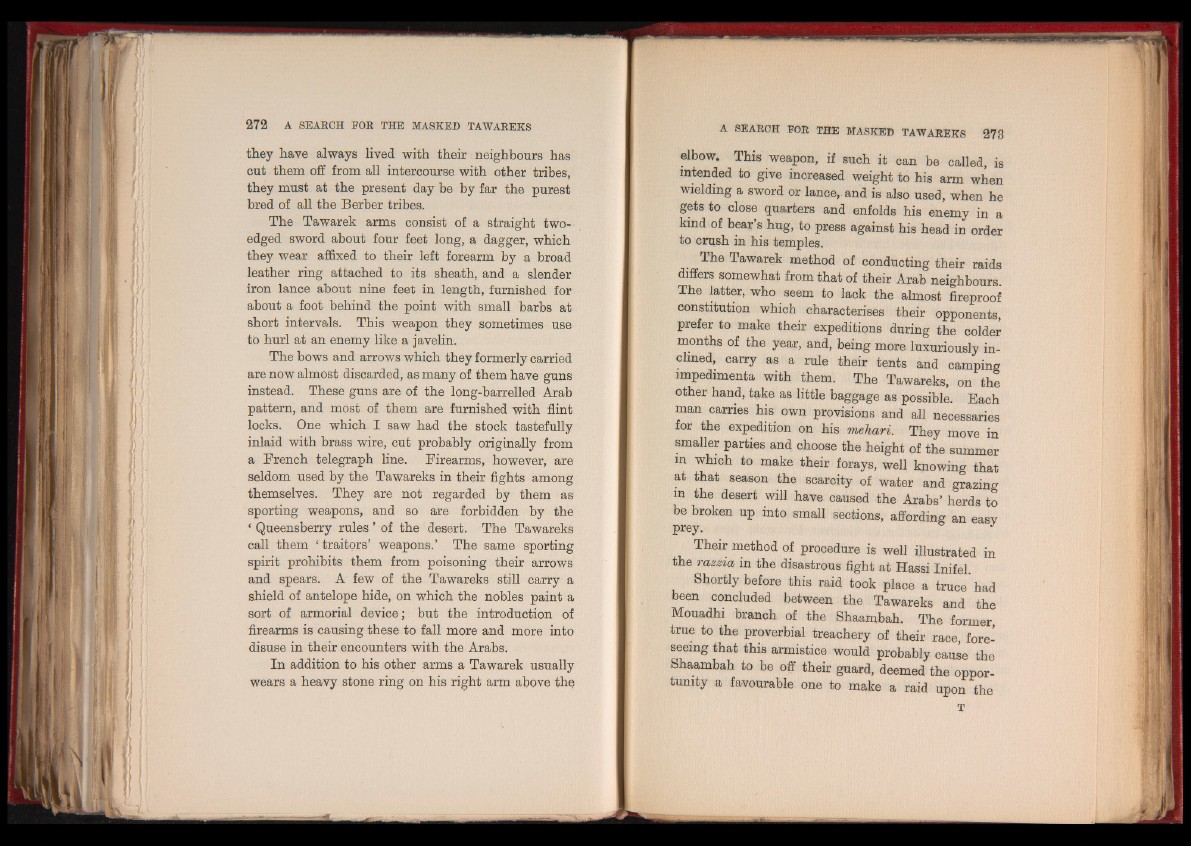
they have always lived with their neighbours has
cut them off from all intercourse with other tribes,
they must at the present day be by far the purest
bred of all the Berber tribes.
The Tawarek arms consist of a straight two-
edged sword about four feet long, a dagger, which
they wear affixed to their left forearm by a broad
leather ring attached to its sheath, and a slender
iron lance about nine feet in length, furnished for
about a foot behind the point with small barbs at
short intervals. This weapon they sometimes use
to hurl at an enemy like a javelin.
The bows and arrows which they formerly carried
are now almost discarded, as many of them have guns
instead. These guns are of the long-barrelled Arab
pattern, and most of them are furnished with flint
locks. One which I saw had the stock tastefully
inlaid with brass wire, cut probably originally from
a French telegraph line. Firearms, however, are
seldom used by the Tawareks in their fights among
themselves. They are not regarded by them as
sporting weapons, and so are forbidden by the
* Queensberry rules ’ of the desert. The Tawareks
call them ‘traitors’ weapons.’ The same sporting
spirit prohibits them from poisoning their arrows
and spears. A few of the Tawareks still carry a
shield of antelope hide, on which the nobles paint a
sort of armorial device; but the introduction of
firearms is causing these to fall more and more into
disuse in their encounters with the Arabs.
In addition to his other arms a Tawarek usually
wears a heavy stone ring on his right arm above the
elbow. This weapon, if such it can be called, is
intended to give increased weight to his arm when
wielding a sword or lance, and is also used, when he
gets to close quarters and enfolds his enemy in a
kind of bear’s hug, to press against his head in order
to crush in his temples.
The Tawarek method of conducting their raids
differs somewhat from that of their Arab neighbours.
The latter, who seem to lack the almost fireproof
constitution which characterises their opponents,
prefer to make their expeditions during the colder
months of the year, and, being more luxuriously inclined,
carry as a rule their tents and camping
impedimenta with them. The Tawareks, on the
other hand, take as little baggage as possible. Each
man carries his own provisions and all necessaries
for the expedition on his mehari. They move in
smaller parties and choose the height of the summer
in which to make their forays, well knowing that
at that season the scarcity of water and grazing
m the desert will have caused the Arabs’ herds to
be broken up into small sections, affording an easy
prey.
Their method of procedure is well illustrated in
the razzw in the disastrous fight at Hassi Inifel
Shortly before this raid took place a truce had
been concluded between the Tawareks and the
Mouadhi branch of the Shaambah. The former
true to the proverbial treachery of their race, foreseeing
that this armistice would probably cause the
Shaambah to be off their guard, deemed the opportunity
a favourable one to make a raid upon the